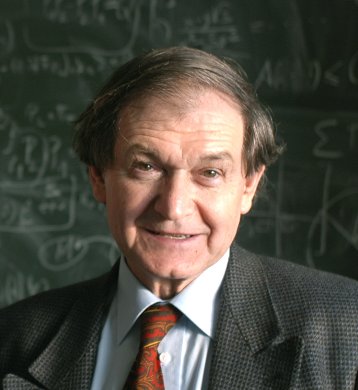University of Colorado
Forty-Third Annual DeLong Lecture Series
Department of Mathematics
Professor Roger Penrose
Conformal Space-Time Geometry, Twistor Theory, and a New Cyclic Cosmology
|
Date |
Time |
Room |
Title |
||
|
Monday, January 29, 2007 |
4:00-5:00 pm |
BESC 180 |
Before the Big Bang: a Novel Resolution of a Profound Cosmological
Puzzle The second law of thermodynamics says, in effect, that things get more "random" as time progresses. This tells us that the beginning of the universe - the "big bang" - must have been an extraordinarily precisely organized (i.e. very non-random) state. What was the particular nature of this state? How can such a special state have come about? In this talk, a novel solution is suggested, which involves an examination of what is to be expected in the very remote future of our universe, with its observed accelerated expansion. My suggested model depends upon a slightly more primitive form of spacetime geometry than Einstein's curved metric geometry, namely conformal geometry in which it is merely the speed of light (in every direction) that provides the needed strucure. (Note: this type of conformal geometry also lies at the basis of twistor theory, which is the subject of the two remaining DeLong Lectures.) |
||
|
Wednesday, January 31, 2007 |
4:00-5:00 pm |
DUAN G1B20 |
Twistor Theory: Old and New Basic twistor geometry and its description of massless free fields Twistor theory revives some 19th-century geometry of Sophus Lie and Felix Klein, and puts it to use to re-express and generalize elegant representations (some put forward at the turn of the 20th century) of some of the most basic fields of physics. The theory indicates a possibly deep role for holomorphic concepts (complex manifold structure, holomorphic sheaf cohomology, complex bundles) in the key equations of physics, relating them to foundational aspects of quantum theory. Some recent developments will be outlined, such as the twistor-string theory promoted by Edward Witten and a novel approach to the resolution of divergences in quantum field theory due to Andrew Hodges. |
||
|
Thursday, February 1, 2007 |
4:00-5:00 pm |
ECCR 245 |
Twistor Theory: Old and New On curved twistor spaces, twistor-strings, and the resolution of quantum divergences Continuation of Lecture II. |
||

Professor Roger Penrose |
||
Roger Penrose was born in 1931. He obtained his B.Sc. (1952, in mathematics) at University College London, and his Ph.D. (1957, in algebraic geometry) at St John's College, Cambridge. He held several teaching and research positions in the UK and USA, particularly at Birkbeck College London. Between 1973 and 1998 he was Rouse Ball Professor of Mathematics at Oxford University and is currently Emeritus Rouse Ball Professor. Since 1993 he has been Francis and Helen Pentz Distinguished (visiting) Professor of Physics and Mathematics at Penn State University. He is married and has four sons. He was elected Fellow of the Royal Society in 1972 and has also been elected to four other national scientific organizations including the National Academy of Sciences. In 1993, he was knighted for services to science, and he received the Order of Merit in 2000. He has received many awards, including Israel's Wolf Foundation Prize for Physics 1988 (with Stephen Hawking) and the London Mathematical Society's DeMorgan Medal 2004, as well as fourteen honorary degrees. His research interests include various aspects of physics and geometry, with many contributions to general relativity theory and the foundations of quantum theory, the introduction of a generalized inverse of matrices, the theory of non-periodic tilings (including the first examples involving only two distinct tiles), and the physical basis of consciousness. He originated twistor theory, a proposal for uniting quantum ideas with space-time structure. He has also made contributions to cosmology, most notably in relation to the geometrical nature of the big bang and its fundamental role in the second law of thermodynamics. He has written many scientific papers and several books, including three technical books, and several semi-popular books such as "The Emperor's New Mind: On Computers, Minds, and the Laws of Physics", which won the 1990 Science Book Prize, "Shadows of the Mind: A Search for the Missing Science of Consciousness", and the recent book "The Road to Reality: A Complete Guide to the Laws of the Universe". |
DeLong Lecture Series | ||
This Lecture Series is funded by an endowment given by Professor Ira M. DeLong, who came to the University of Colorado in 1888 at the age of 33. Professor DeLong essentially became the mathematics department by teaching not only the college subjects but also the preparatory mathematics courses. Professor DeLong was a prominent citizen of the community of Boulder as well as president of the Mercantile Bank and Trust Company, organizer of the Colorado Education Association, and president of the charter convention that gave Boulder the city manager form of government in 1917. After his death in 1942, it was decided that the bequest he made to the mathematics department would accumulate interest until income became available to fund DeLong prizes for undergraduates and DeLong Lectureships to bring outstanding mathematicians to campus each year. |
||
|
|
CU Math Home